高中英语_名著阅读教学课件设计
- 格式:ppt
- 大小:15.61 MB
- 文档页数:17

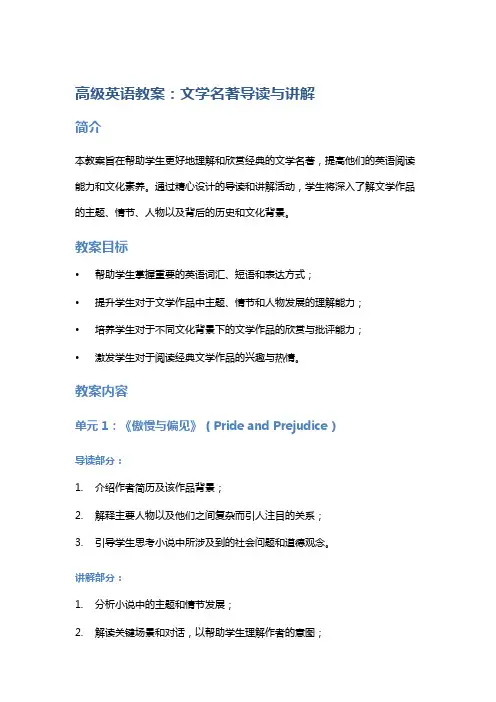
高级英语教案:文学名著导读与讲解简介本教案旨在帮助学生更好地理解和欣赏经典的文学名著,提高他们的英语阅读能力和文化素养。
通过精心设计的导读和讲解活动,学生将深入了解文学作品的主题、情节、人物以及背后的历史和文化背景。
教案目标•帮助学生掌握重要的英语词汇、短语和表达方式;•提升学生对于文学作品中主题、情节和人物发展的理解能力;•培养学生对于不同文化背景下的文学作品的欣赏与批评能力;•激发学生对于阅读经典文学作品的兴趣与热情。
教案内容单元1:《傲慢与偏见》(Pride and Prejudice)导读部分:1.介绍作者简历及该作品背景;2.解释主要人物以及他们之间复杂而引人注目的关系;3.引导学生思考小说中所涉及到的社会问题和道德观念。
讲解部分:1.分析小说中的主题和情节发展;2.解读关键场景和对话,以帮助学生理解作者的意图;3.讨论小说中的文化与历史背景,对其写作背景进行深入了解。
单元2:《1984》导读部分:1.介绍乔治·奥威尔并探讨他的观点和价值观;2.梳理小说中的重要角色,描述他们的性格特点及情节发展。
3.引导学生思考小说中所反映的政治恐怖主义和权力滥用等问题。
讲解部分:1.分析小说呈现出来的社会、政治和心理面貌;2.解读作者运用技巧(如语言运用、象征手法等)达到表达意图的目的;3.探究小说中所传达出来的警示和批判精神,并与当代社会联系起来。
单元3:《了不起的盖茨比》(The Great Gatsby)导读部分:1.简要介绍斯科特·菲茨杰拉德以及作品背后的历史背景;2.描述主要人物及其对故事发展的影响;3.引导学生思考小说中所折射出的社会阶层和道德问题。
讲解部分:1.分析小说中的主题和象征意义;2.解读作者所刻画的角色形象、情节发展,并分析其含义;3.探讨小说中对于追求美国梦和现实世界之间冲突的思考。
教案评估为了评估学生的学习成果,教师可以使用以下方式进行评估:- 课堂互动讨论,检验学生对于文学作品的理解程度; - 学生书面作业,包括结构化问题、评论性文章等形式; - 小组或个人项目,鼓励学生通过演讲或展示方式分享他们对于文学作品的独特观点。
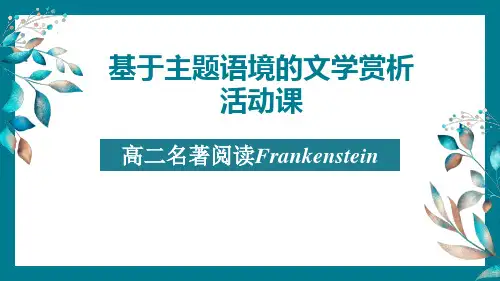
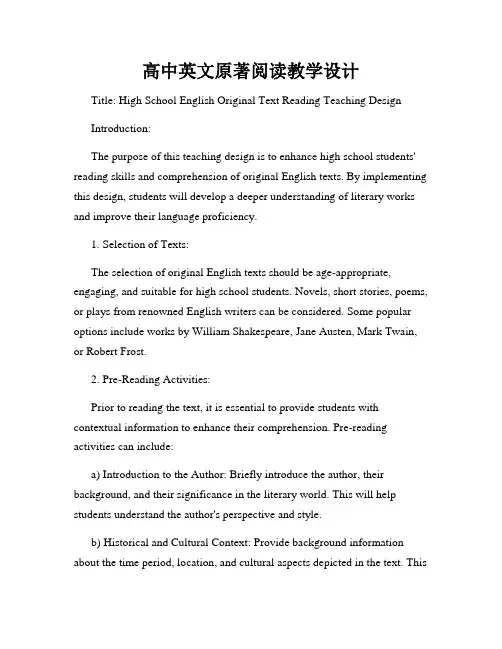
高中英文原著阅读教学设计Title: High School English Original Text Reading Teaching DesignIntroduction:The purpose of this teaching design is to enhance high school students' reading skills and comprehension of original English texts. By implementing this design, students will develop a deeper understanding of literary works and improve their language proficiency.1. Selection of Texts:The selection of original English texts should be age-appropriate, engaging, and suitable for high school students. Novels, short stories, poems, or plays from renowned English writers can be considered. Some popular options include works by William Shakespeare, Jane Austen, Mark Twain, or Robert Frost.2. Pre-Reading Activities:Prior to reading the text, it is essential to provide students with contextual information to enhance their comprehension. Pre-reading activities can include:a) Introduction to the Author: Briefly introduce the author, their background, and their significance in the literary world. This will help students understand the author's perspective and style.b) Historical and Cultural Context: Provide background information about the time period, location, and cultural aspects depicted in the text. Thiswill enable students to understand the social context and enhance their understanding of the story.c) Vocabulary Expansion: Introduce key vocabulary words and phrases found in the text. Use exercises and activities to reinforce students' understanding and encourage them to use these words in context.3. During Reading Activities:While students are reading the text, it is essential to engage them actively to enhance their comprehension. Some effective during-reading activities include:a) Guided Reading Questions: Provide students with a list of comprehension questions to guide their reading. These questions should cover plot, character development, themes, and literary techniques used in the text. Students can discuss these questions in pairs or small groups.b) Annotation and Highlighting: Encourage students to annotate and highlight important passages, unfamiliar words, or literary devices they come across. This practice helps them actively engage with the text and facilitates discussion.c) Character Analysis: Assign students the task of analyzing the main characters in the text. They can create character profiles, discuss their actions, motivations, and analyze their role in the plot.4. Post-Reading Activities:After students have completed reading the text, it is essential to reinforce their understanding and encourage reflection. Some post-reading activities include:a) Group Discussions: Organize group discussions where students can share their thoughts, interpretations, and opinions about the text. Encourage them to support their ideas with evidence from the text.b) Creative Assignments: Assign creative projects such as writing alternative endings, creating a visual representation of a scene, or composing a poem inspired by the text. These activities promote critical thinking and a deeper engagement with the text.c) Comparative Analysis: Ask students to compare the text they have read with other works by the same author, or with literature from different time periods or cultures. This encourages them to make connections and draw broader conclusions about themes and writing styles.Conclusion:By incorporating this teaching design into high school English classes, students will develop a deeper appreciation for original English texts and strengthen their reading and analytical skills. This method not only fosters language proficiency but also promotes critical thinking and cultural understanding. Through engaging activities, students are empowered to explore the world of literature and become confident readers of English original works.。
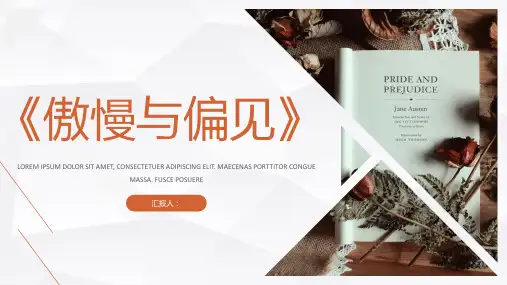

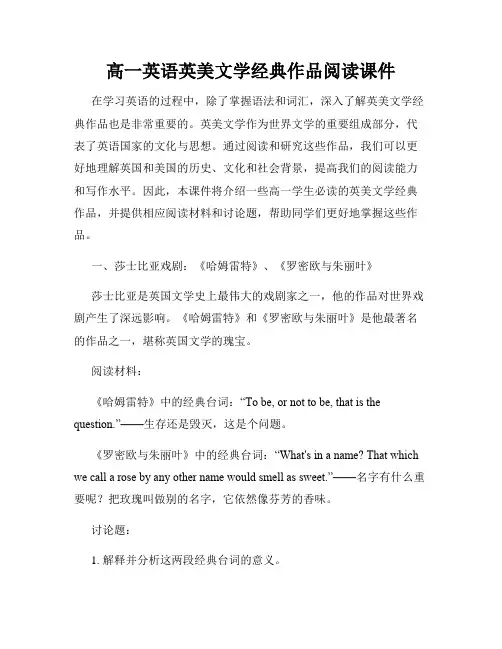
高一英语英美文学经典作品阅读课件在学习英语的过程中,除了掌握语法和词汇,深入了解英美文学经典作品也是非常重要的。
英美文学作为世界文学的重要组成部分,代表了英语国家的文化与思想。
通过阅读和研究这些作品,我们可以更好地理解英国和美国的历史、文化和社会背景,提高我们的阅读能力和写作水平。
因此,本课件将介绍一些高一学生必读的英美文学经典作品,并提供相应阅读材料和讨论题,帮助同学们更好地掌握这些作品。
一、莎士比亚戏剧:《哈姆雷特》、《罗密欧与朱丽叶》莎士比亚是英国文学史上最伟大的戏剧家之一,他的作品对世界戏剧产生了深远影响。
《哈姆雷特》和《罗密欧与朱丽叶》是他最著名的作品之一,堪称英国文学的瑰宝。
阅读材料:《哈姆雷特》中的经典台词:“To be, or not to be, that is the question.”——生存还是毁灭,这是个问题。
《罗密欧与朱丽叶》中的经典台词:“What's in a name? That which we call a rose by any other name would smell as sweet.”——名字有什么重要呢?把玫瑰叫做别的名字,它依然像芬芳的香味。
讨论题:1. 解释并分析这两段经典台词的意义。
2. 你认为《哈姆雷特》和《罗密欧与朱丽叶》对当代社会还有什么启示和价值?二、查尔斯·狄更斯小说:《雾都孤儿》、《呼啸山庄》狄更斯是英国维多利亚时代最杰出的小说家之一,他的作品展现了当时社会的黑暗面和人性的复杂性。
他的小说以鲜明的人物形象、生动的情节和深刻的社会批判著称。
阅读材料:《雾都孤儿》中的经典句子:“Please, sir, I want some more.”——劳模奥利弗向冷酷的监工要求更多的食物。
《呼啸山庄》中的经典句子:“He's more myself than I am. Whatever our souls are made of, his and mine are the same.”——他比我自己更像我,无论我们的灵魂是由什么构成的,他的和我的是一样的。


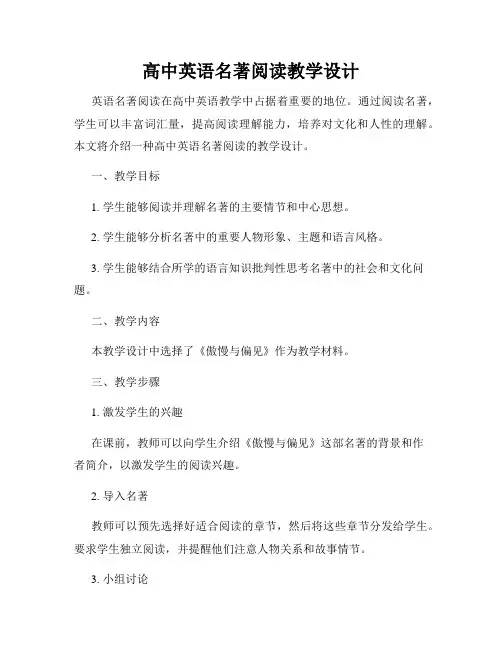
高中英语名著阅读教学设计英语名著阅读在高中英语教学中占据着重要的地位。
通过阅读名著,学生可以丰富词汇量,提高阅读理解能力,培养对文化和人性的理解。
本文将介绍一种高中英语名著阅读的教学设计。
一、教学目标1. 学生能够阅读并理解名著的主要情节和中心思想。
2. 学生能够分析名著中的重要人物形象、主题和语言风格。
3. 学生能够结合所学的语言知识批判性思考名著中的社会和文化问题。
二、教学内容本教学设计中选择了《傲慢与偏见》作为教学材料。
三、教学步骤1. 激发学生的兴趣在课前,教师可以向学生介绍《傲慢与偏见》这部名著的背景和作者简介,以激发学生的阅读兴趣。
2. 导入名著教师可以预先选择好适合阅读的章节,然后将这些章节分发给学生。
要求学生独立阅读,并提醒他们注意人物关系和故事情节。
3. 小组讨论将学生分成小组,让他们就阅读的章节展开讨论。
学生可以讨论他们对人物和事件的看法,分享自己的观点并提出问题。
教师可以作为引导者,促进学生之间的互动和思考。
4. 全班展示每个小组选出一名代表,向全班汇报他们小组的讨论成果。
其他的学生可以提出问题或者给予补充。
这样可以促进全班同学对名著的全面理解和思考。
5. 阅读指导教师可以介绍一些阅读名著的技巧和策略,例如如何理解复杂句子、如何分析人物形象等。
这对于学生提高阅读效果和深入理解名著非常有帮助。
6. 语言学习以名著中的经典语句为例,教师可以引导学生仔细品读,解释一些生词和短语的意思,并分析语言风格和修辞手法。
通过这样的活动,学生能够提高词汇水平和语言表达能力。
7. 文化扩展教师可以结合名著中的情节和主题,向学生介绍一些与之相关的文化知识。
例如,介绍英国社交规则、乡村风情等。
这样有助于学生了解文化背景并扩展他们的文化视野。
8. 学生作业请学生写一篇读后感,分享他们对名著的理解和感悟。
这样可以促进学生运用所学知识,提高写作能力和思考能力。
通过上述教学步骤,学生能够系统地学习并理解英语名著。

课程名称:英语名著阅读课程课程目标:1. 培养学生对英语名著的兴趣和阅读习惯。
2. 提高学生的英语阅读理解能力,拓宽知识面。
3. 培养学生的批判性思维和跨文化交际能力。
4. 增强学生的语言表达能力,提高口语水平。
教材选择:《傲慢与偏见》(Pride and Prejudice)教学时间:2课时教学对象:高中一年级教学准备:1. 教材:《傲慢与偏见》原著及电子版。
2. 教学课件:包含课文摘要、人物关系图、词汇表等。
3. 互动讨论环节:准备相关话题,引导学生参与讨论。
教学过程:第一课时一、导入1. 利用多媒体展示《傲慢与偏见》的封面、作者及背景信息,激发学生的兴趣。
2. 简要介绍小说的主要内容,引导学生对故事背景有所了解。
二、课文阅读1. 学生自主阅读课文,完成课后练习题。
2. 教师检查学生的阅读情况,纠正错误,讲解重点词汇和句型。
三、课堂讨论1. 教师引导学生根据课文内容,讨论以下话题:a. 主人公伊丽莎白·班纳特的性格特点及其成因。
b. 贝内特家的其他成员的性格特点及其与伊丽莎白的关系。
c. 小说中的人物关系及其对故事发展的影响。
2. 学生分组讨论,每组选派代表进行发言。
四、总结1. 教师总结本节课的重点内容,强调阅读理解技巧。
2. 布置课后作业,要求学生完成以下任务:a. 搜集关于《傲慢与偏见》的相关资料,撰写一篇读书心得。
b. 分析小说中的人物关系,绘制人物关系图。
第二课时一、导入1. 回顾上一节课的内容,引导学生回顾故事情节。
2. 提出本节课的学习目标。
二、课文阅读1. 学生自主阅读课文,完成课后练习题。
2. 教师检查学生的阅读情况,纠正错误,讲解重点词汇和句型。
三、课堂讨论1. 教师引导学生根据课文内容,讨论以下话题:a. 分析小说中的爱情观及其对当代爱情观念的影响。
b. 探讨小说中的社会背景及其对人物命运的影响。
c. 分析小说中的讽刺手法及其对主题的揭示。
2. 学生分组讨论,每组选派代表进行发言。
英语名著教学设计教学设计:英语名著教学设计(适用于高中阶段)教学目标:1. 学习和掌握英语名著的基本背景、作者和主要人物等知识。
2. 熟悉和理解英语名著的故事情节和主题,培养学生的阅读理解能力。
3. 提高学生的英语写作能力,鼓励他们进行文学评论和分析。
教学内容:1. 选取合适的英语名著,包括但不限于《傲慢与偏见》、《雾都孤儿》、《呼啸山庄》等,确保故事情节丰富且容易理解。
2. 学习英语名著的背景知识,包括作者的生平及作品背景。
了解作者的时代背景和文化背景,有利于更好地理解和欣赏英语名著。
3. 学习英语名著的主要人物,包括他们的性格、行为和角色等。
通过分析主要人物的形象和发展,培养学生对人物性格的观察能力。
4. 阅读名著的故事情节,理解其中的情节转折和发展。
通过指导学生进行阅读和讨论,帮助他们深入了解故事情节。
5. 探讨英语名著的主题和思想,引导学生思考和分析作品中的主旨和意义。
鼓励学生进行文学评论和分析,提高其写作能力。
教学过程:1. 导入(10分钟):介绍英语名著的定义及背景,引起学生的兴趣和好奇心。
2. 阶段一:背景知识学习(30分钟)a. 分组讨论:将学生分成小组,每组负责研究一个英语名著的背景知识,包括作者的生平和作品背景等。
每个小组通过互相交流和讨论,然后向全班展示他们所研究的内容。
b. 教师讲解:补充和扩展学生所研究的背景知识,并与学生互动交流。
3. 阶段二:主要人物学习(30分钟)a. 教师讲解:介绍英语名著的主要人物,并详细讨论他们的性格、行为和角色等。
鼓励学生提问和互动交流,促进他们对人物的深入理解。
b. 学生活动:学生根据教师的指导,分析并描述英语名著中的主要人物,并在小组中进行讨论。
4. 阶段三:故事情节阅读(40分钟)a. 学生阅读:学生分组阅读名著的故事情节,在阅读过程中记录关键情节,了解故事的发展和转折点。
b. 小组讨论:学生在小组中讨论故事情节,分享各自的理解和观点。